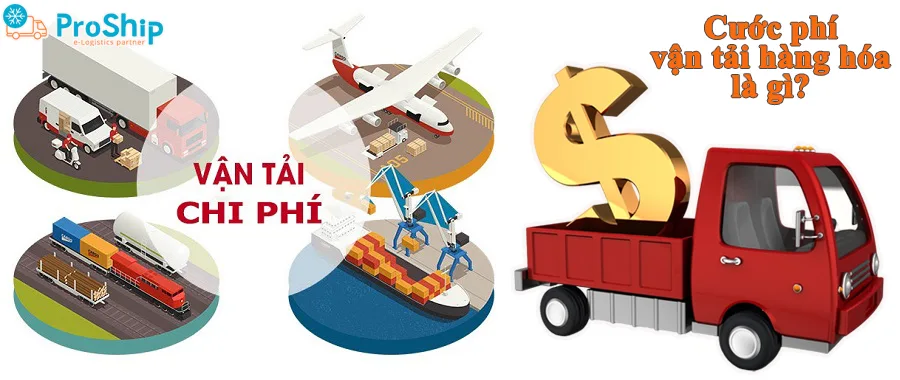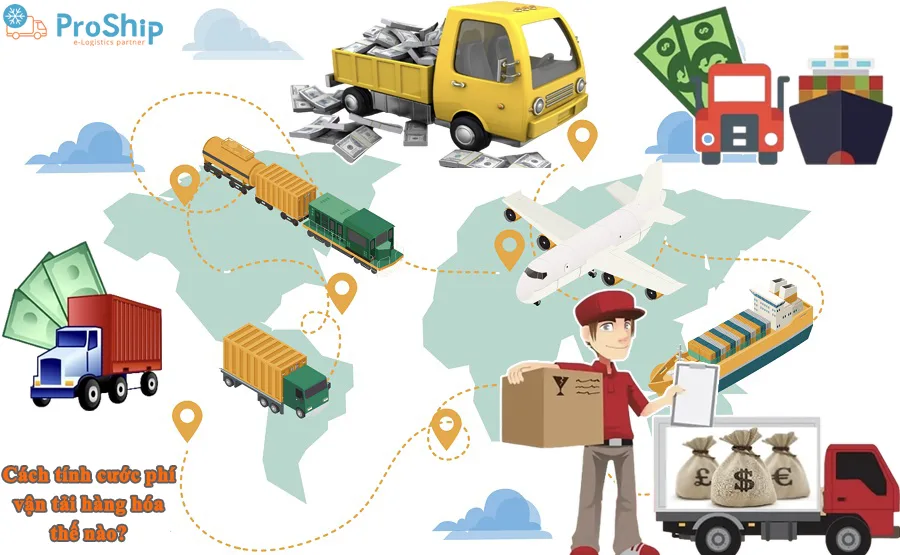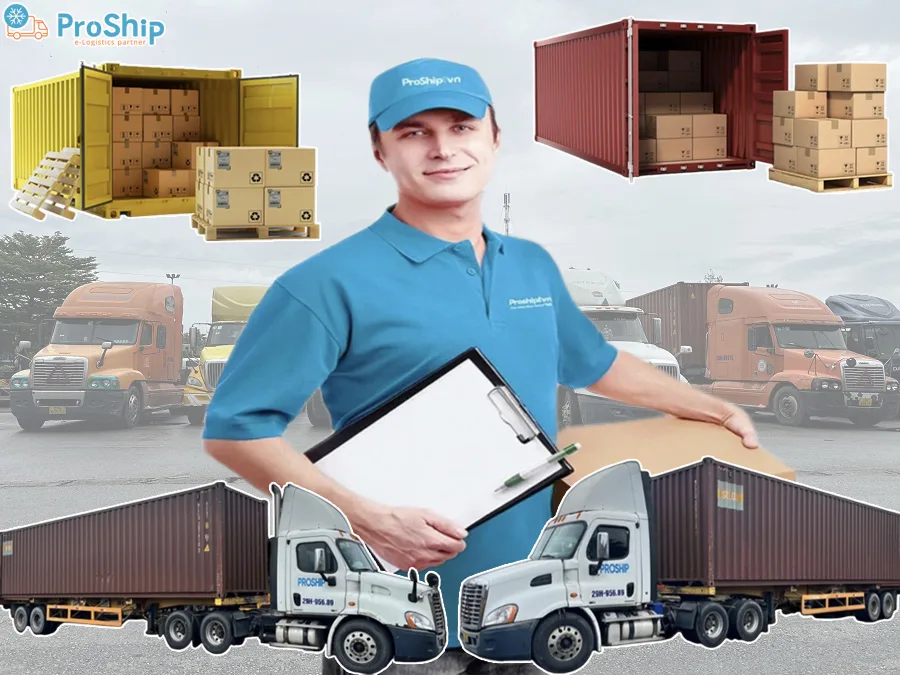x Bạn là cá nhân, là doanh nghiệp cần gửi hàng liên tỉnh theo nhiều phương thức vận chuyển khác nhau và quan tâm tới quy định về cách tính cước vận chuyển ra sao?
x Bạn chưa có kinh nghiệm so sánh cước vận chuyển hàng hóa bằng đường sắt, cước vận chuyển hàng hóa bằng đường bộ, cước vận chuyển hàng hóa đường hàng không, đường biển giữa các Đơn vị vận tải trên thị trường?
x Bạn muốn biết yếu tố nào quyết định giá cước vận chuyển hàng hóa? Có hay không cách giảm thiểu thấp nhất khoản chi phí này khi gửi hàng đi xa?
Cùng với chất lượng và thời gian vận chuyển thì cước phí gửi hàng là điều mà nhiều người quan tâm khi chọn một Dịch vụ vận tải. Proship.vn chúng tôi sẽ cập nhật cước phí vận chuyển mới nhất theo từng phương thức đường bộ, đường sắt, đường thủy và đường hàng không ngay sau đây.
>>Có thể bạn quan tâm: Bảo đảm hàng hải là gì – Tải trọng xe là gì – Xe lôi là xe gì – Gửi hàng đi Huế – Dịch vụ vận tải hàng hóa
Cước phí vận tải hàng hóa nghĩa là gì?
Cước phí vận chuyển là khoản phí mà khách hàng phải chi trả cho các Đơn vị vận chuyển để gửi hàng từ nơi này đến nơi khác theo yêu cầu. Khách hàng có nhu cầu chuyển hàng hoặc làm trong Ngành xuất nhập khẩu đều cần biết cách tính cước vận chuyển này.

Mỗi Đơn vị vận tải khác nhau sẽ có những cách tính chi phí vận chuyển khác nhau ứng với từng hình thức vận chuyển. Song bất kể cước vận chuyển hàng hóa được tính thế nào thì vẫn phải tuân thủ một số nguyên tắc nhất định của Ngành vận tải nói chung.
Cách tính cước phí theo từng phương thức vận tải hàng hóa thế nào?
Ngoài yếu tố thời gian và chất lượng thì cước phí vận chuyển cũng là yếu tố được nhiều khách hàng quan tâm. Giá cước vận chuyển hàng hóa mà các Công ty vận tải, Nhà xe, Chành xe áp dụng phải tuân thủ quy định của Nhà nước.
Dưới đây là quy định về tính cước phí vận chuyển hàng hóa mới nhất 2024 vừa được ban hành:
Tính cước phí vận tải hàng hóa đường sắt
Cách tính cước vận chuyển hàng hóa bằng đường sắt được tính theo quy định trong Thông tư 83/2014 của Bộ Giao thông Vận tải. Theo đó, đơn hàng lẻ được tính theo trọng lượng thực tế của kiện hàng, nặng tối đa 20kg và nặng trên 20kg, số lẻ tính thành 5kg.
Với những đơn hàng có số lượng lớn, bao nguyên một toa tàu thì giá cước vận chuyển hàng hóa bằng tàu hỏa được tính theo trọng tải kỹ thuật cho phép của toa tàu đó.
Tính cước phí vận tải hàng hóa đường bộ
Gửi hàng hóa bằng đường bộ hiện là phương thức vận chuyển được nhiều người lựa chọn. Theo đó, cách tính cước phí vận chuyển đường bộ khá đơn giản:
Cước phí vận chuyển = Khối lượng hàng hóa x Đơn giá vận chuyển của vùng nhận hàng so với vùng gửi hàng
Với những đơn hàng quá cồng kềnh, khối lượng của hàng hóa sẽ được tính theo công thức:
(Chiều dài x chiều rộng x chiều cao)/5000
Từ công thức trên có thể suy ra giá cước vận chuyển hàng hóa bằng đường bộ bao nhiêu để các Đơn vị vận tải thông báo tới khách gửi hàng là cá nhân hoặc doanh nghiệp.

Tính cước phí vận tải hàng hóa đường hàng không
Cách tính cước phí vận chuyển hàng hóa bằng đường hàng không dựa theo những quy định riêng do Hiệp hội vận tải hàng không quốc tế International Air Transport Association quy định. Công thức tính:
Cước phí vận chuyển = Đơn giá x Khối lượng kiện hàng
Tính cước phí vận tải hàng hóa đường thủy
Cước phí vận chuyển đường thủy tùy thuộc vào nhiều yếu tố như khoảng cách, trọng lượng, tàu vận chuyển và phí dịch vụ của đơn vị vận chuyển trung gian. Người gửi có thể tham khảo 2 cách thức sau được nhiều Công ty vận tải áp dụng:
Cách tính cước phí gửi hàng bằng đường thủy:
- Tính cước phí vận chuyển theo trọng lượng thực tế của kiện hàng kể cả bao bì đóng gói theo đơn vị Kg.
- Cước phí vận chuyển được tính theo thể tích kiện hàng, công thức: Chiều dài x chiều rộng x chiều cao.
Yếu tố nào ảnh hưởng đến chi phí vận tải hàng hóa?
Các yếu tố ảnh hưởng tới giá cước phí vận chuyển như:
Số lượng hàng hóa cần vận tải
Số lượng hàng hóa càng nhiều, các Đơn vị vận tải sẽ tính cước vận chuyển càng cao. Do đó, trước khi chọn một Đơn vị vận chuyển hay phương thức vận chuyển, bạn cần cân nhắc đến số lượng hàng hóa để chọn sao cho phù hợp, tránh lãng phí khoản tiền vận chuyển.
Khoảng cách vận tải
Yếu tố về Khoảng cách vận chuyển hàng hóa sẽ tác động nhiều đến chi phí vận chuyển. Nếu vận chuyển hàng hóa một quãng đường xa, giá cước vận chuyển sẽ tăng, bởi:
- Trên quãng đường xa, tài xế phải di chuyển trong thời gian dài để đảm bảo hàng đến điểm nhận đúng thời gian cam kết;
- Khi vận chuyển hàng hóa trong một quãng đường dài cần phải tiêu tốn một lượng nhiên liệu lớn;
- Trong quá trình vận chuyển hàng hóa đi xa, hàng hóa cũng dễ gặp phải các rủi ro không mong muốn trên đường.
Loại hàng hóa vận tải
Mỗi loại hàng sẽ có mức giá cước vận chuyển hàng hóa khác nhau:
- Hàng hóa là thực phẩm khô hay hàng tiêu dùng bình thường như: bánh kẹo, quần áo,…sẽ dễ vận chuyển và nếu gặp rủi ro sẽ không gây tổn thất quá nhiều;
- Hàng hóa là thiết bị điện tử, điện lạnh nếu trong quá trình vận chuyển gặp rủi ro sẽ mất giá trị sử dụng ngay nên rất cần quy trình vận chuyển chuyên nghiệp, khoa học khiến cước vận chuyển hàng hóa cũng khác hơn;
- Hàng hóa dễ vỡ như bình thủy tinh, chén bát sứ, cốc,…cần đóng gói cẩn thận và vận chuyển cẩn thận hơn nên giá vận chuyển cũng cao hơn.
Làm sao để giảm cước phí vận tải hàng hóa?
Proship Logistics mách bạn cách giảm cước vận chuyển hàng hóa hiệu quả, dù là cước vận chuyển hàng hóa bằng đường sắt, cước vận chuyển hàng hóa bằng đường bộ cũng NÊN ÁP DỤNG:
Sử dụng bao bì đóng gói phù hợp
Một số hãng vận chuyển thường có quy định về kích thước hàng hóa, hãy cân nhắc việc sử dụng bao bì đóng gói cho phù hợp. Tùy từng loại hàng hóa mà chọn hộp 3 lớp hay 5 lớp, thùng carton nhỏ hay lớn, có thêm giấy chèn lót hàng/màng hơi hay không,…
Tham khảo nhiều hãng vận tải khác nhau
Bạn có thể tham khảo nhiều Hãng vận chuyển để chọn nơi có chính sách tính cước vận chuyển phù hợp nhất. Nếu bạn có nhiều đơn hàng và mong muốn hợp tác lâu dài, có thể bạn sẽ được hưởng cước phí vận chuyển đi kèm với những chính sách ưu đãi đặc biệt đến từ các hãng vận chuyển.

Đặt kho hàng gần nơi đặt phương tiện vận tải
Nếu kho hàng của bạn gần với phương tiện vận tải sẽ tiết kiệm được một khoảng thời gian và chi phí không nhỏ cho việc vận chuyển hàng hóa.
Proship Logistics chúng tôi đã vừa cập nhật đến Quý bạn đọc và doanh nghiệp, tư nhân tất tần tật quy định về tính cước phí vận chuyển hàng hóa, bao gồm đường bộ, giá cước vận chuyển hàng hóa bằng tàu hỏa, đường hàng không và đường biển.
Mọi thắc mắc liên quan tới cước vận chuyển hàng hóa bằng đường sắt, cước vận chuyển hàng hóa bằng đường bộ,…liên hệ ngay 0909 344 247 để được tư vấn về các loại hình dịch vụ bạn quan tâm.
